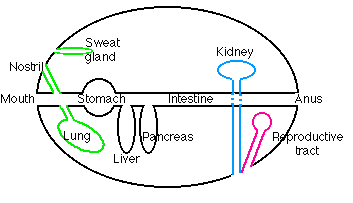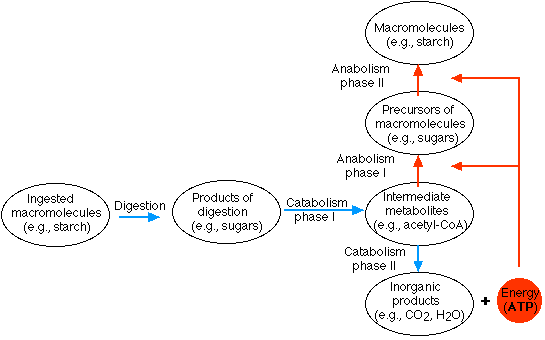Metabolism
All living things must have an unceasing supply of energy and matter. The transformation of this energy and matter within the body is called metabolism.
Catabolism
Catabolism is destructive metabolism. Typically, in catabolism, larger organic molecules are broken down into smaller constituents. This usually occurs with the release of energy (usually as ATP).
Anabolism
Anabolism is constructive metabolism. Typically, in anabolism, small precursor molecules are assembled into larger organic molecules. This always requires the input of energy (often as ATP).
Autotrophic Nutrition
Green plants, algae, and some bacteria are autotrophs ("self-feeders"). Most of them use the energy of sunlight to assemble inorganic precursors, chiefly carbon dioxide and water, into the array of organic macromolecules of which they are made. The process is photosynthesis. Photosynthesis makes the ATP needed for the anabolic reactions in the cell.
Heterotrophic Nutrition
All other organisms, including ourselves, are heterotrophs. We secure all our energy from organic molecules taken in from our surroundings ("food"). Although heterotrophs may feed partially (as most of us do) or exclusively on other heterotrophs, all the food molecules come ultimately from autotrophs. We may eat beef but the steer ate grass.
Heterotrophs degrade some of the organic molecules they take in (catabolism) to make the ATP that they need to synthesize the others into the macromolecules of which they are made (anabolism).
How humans (and other animals) do it.
 Humans are heterotrophs. We are totally dependent on ingested preformed organic molecules to meet all our energy needs.
We are also dependent on preformed organic molecules as the building blocks to meet our anabolic needs.
Humans are heterotrophs. We are totally dependent on ingested preformed organic molecules to meet all our energy needs.
We are also dependent on preformed organic molecules as the building blocks to meet our anabolic needs.
The steps.
- Ingestion: taking food within the body (although as the figure shows, it is still topologically in the external world, not the internal).
- Digestion.
The enzyme-catalyzed hydrolysis of
- polysaccharides (e.g., starch) to sugars
- proteins to amino acids
- fats to fatty acids and glycerol
- nucleic acids to nucleotides
- Absorption into the body and transport to the cells.
- Absorption into cells

Within cells, these molecules are further degraded into still simpler molecules containing two to four carbon atoms. These fragments (acetyl-CoA for example) face one of two alternatives:
- They may proceed up various metabolic pathways and serve as the building blocks of, for example, sugars and fatty acids. From these will be assembled the macromolecules of the cell:
- polysaccharides
- fats
- proteins
- nucleic acids
Or the molecules in this pool of two- to four-carbon fragments may be still further degraded - ultimately to simple inorganic molecules such as carbon dioxide (CO2), H2O, and ammonia (NH3).
This phase of catabolism releases large amounts of energy (in the form of ATP). One use to which this energy is put is to run the anabolic activities of the cell.
10 June 1999
 Humans are heterotrophs. We are totally dependent on ingested preformed organic molecules to meet all our energy needs.
We are also dependent on preformed organic molecules as the building blocks to meet our anabolic needs.
Humans are heterotrophs. We are totally dependent on ingested preformed organic molecules to meet all our energy needs.
We are also dependent on preformed organic molecules as the building blocks to meet our anabolic needs.
